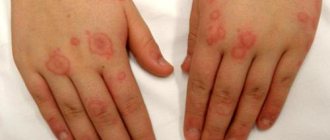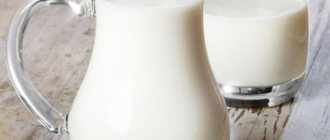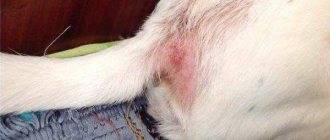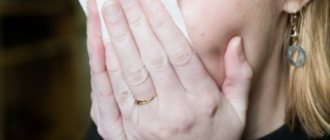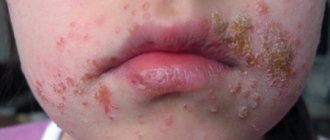Children are very susceptible to environmental influences, as they still have a dynamic, plastic immune system.
In the first month of life, the child is protected by the mother's immunity, which he acquired in the womb.
And subsequently, the baby begins to form his own, which will protect him from various irritants throughout his life.
A child under one year old has extremely unstable protection, so it is during this period that the first allergic reactions occur. The sun is the strongest catalyst for the malfunction of the immune system, so very often young children develop an allergy to the sun.
Causes of sun allergies
The sun's rays themselves do not contain allergens. Why do some people, including young children, exhibit all the signs of an allergic reaction when exposed to ultraviolet radiation? The sun “launches” it, acting as a catalyst. The onset of a phototoxic process in the body can be caused by the following reasons:
- pellagra is a rare disease associated with nicotinic acid deficiency;
- Gunther's disease is a rare form of photodermatosis, a recessive mutation (according to some scientists, people suffering from Gunther's syndrome were mistaken for vampires in the Middle Ages);
- photosensitizers entering the body from drugs, household chemicals, food additives, hygiene or cosmetic products;
- tattooing - cadmium sulfate, used when applying a pattern to the skin, can provoke a phototoxic reaction;
- food products, especially those foods that contain a large amount of dyes, preservatives and flavors.
The risk group for developing sun allergies includes people suffering from individual intolerance to chocolate, nuts and coffee. Also, more often than others, an allergy to ultraviolet radiation manifests itself in patients with the first (Celtic) skin phototype - they can experience burns after a few minutes of exposure to the sun.
Features of treatment
The first thing to do when symptoms of an allergy to ultraviolet light appear is to limit the child’s contact with the sun, protecting him from sunbathing. It is recommended to wear closed clothes on your baby and go outside if there is shade.
You should avoid products that contain dyes and preservatives. Citrus fruits, nuts, strawberries, and honey are prohibited.
Ointments and creams restore the integrity of the skin, relieve irritation and moisturize it, and eliminate itching. Products should be quickly absorbed and not form a film on the surface of the skin.
Do not use cream that is too greasy. It prevents the skin from breathing and slows down the healing process.
The most effective ointments for allergic reactions:
- Fenistil;
- Elokom;
- La Cree;
- Skin Cap.
It is recommended to treat the skin of infants and older children with ointments twice a day. Some creams are hormonal, so you need to discuss their use with your doctor.
Antihistamines are first aid for photoallergy in children. They reduce swelling and redness and help eliminate pain. It is allowed to take antihistamines in any form, but drops are better for infants.
Common drugs in this group are:
All of these drugs cause drowsiness to one degree or another and reduce appetite. Only a doctor should determine the exact dosage and duration of use. In particularly severe cases, corticosteroids are prescribed. However, the course of treatment with such drugs should be short - no more than 5 days. Otherwise, this may result in complications (erythema, vasodilation).
The etiological factor in the occurrence of photoallergy is often vitamin deficiency. In order for the treatment of pathology to be successful, it is necessary to take vitamins E, C, B and nicotinic acid.
You can buy vitamins in capsules and tablets at any pharmacy. You can get all the necessary vitamins from food: vegetables, berries, fruits and drinks made from them.
Enterosorbents are necessary to cleanse the body of possible allergens and normalize digestion. Children with sun allergies are prescribed:
- Tablets (activated carbon). Coal is allowed to be taken up to 4 times a day.
- Powder (Smecta, Polysorb). The products should be taken no more than 3 times a day. The powder is diluted with warm water and used between meals.
Proper drinking regimen can help remove allergens faster after being in the heat. It is necessary to drink from 2 to 2.5 liters of purified water per day. It is impossible for very young patients to take such a volume of liquid, but in the summer it should be given as often as possible.
If it is not possible to consult a doctor, then folk remedies will help to cope with the symptoms of an allergy to the sun's rays. Plant juice and herbal infusions can get rid of itching and reduce pain. For this purpose, use:
Types of allergies to ultraviolet light
Depending on what causes an allergy to ultraviolet radiation, the pathological condition is divided into two main types. This is a photodermatosis of endogenous origin, that is, caused by congenital pathologies, and photodermatitis of an exogenous nature, provoked by the action of photosensitizers.
Exogenous photodermatitis (exposure to photosensitizers)
Exogenous photodermatitis develops under the influence of provoking substances that enter the body or onto the human skin. This type of allergy often affects people who have recently undergone an aggressive peeling procedure, so beauty salons specifically stipulate the need to refrain from prolonged exposure to the sun for a while. Taking a number of medications can also cause a phototoxic reaction:
READ ALSO: Ointments that draw pus from a boil (boil): list of the most effective
- antihistamines;
- barbiturates;
- neuroleptics;
- NSAIDs (Aspirin, Ibuprofen);
- drugs for the treatment of cardiovascular pathologies;
- hormonal medications;
- medicines against diabetes;
- antibacterial agents (including antibiotics of the tetracycline group);
- preparations for the treatment of skin diseases.
Exogenous photodermatitis
Also, an allergic reaction of an exogenous type can result from exposure to various substances that can come into contact with the skin in everyday life. These include oils (bergamot, sandalwood, sea buckthorn, St. John's wort, rose), pollen, parsley and dill juice, eosin, retinols, phenol, musk and so on.
Endogenous photodermatosis (congenital pathologies)
Only an experienced, qualified specialist can diagnose and treat endogenous photodermatosis. Such pathologies are extremely rare and represent congenital mutations and diseases, sometimes they are of hereditary origin. Such diseases include:
- Bazin's light pox;
- sun prurigo;
- solar eczema;
- porphyria;
- xeroderma pigmentosa.
Characteristic allergy symptoms
The symptoms of photodermatitis are very similar to the manifestations of any other allergic reactions, including to food. However, if almost immediately after exposure to ultraviolet light a small rash appears on the skin, and the lesions turn red, an allergy to the sun can be suspected.
In some cases, we will be talking about delayed manifestation of symptoms - then the first signs are noticeable some time after exposure to the sun (“delay” can be up to 12 hours). Characteristic signs of allergies are:
- dizziness;
- headache;
- heat;
- general malaise;
- peeling of the skin, burning sensation, itching (of varying intensity) in the affected areas;
- redness of areas of the skin directly exposed to ultraviolet radiation, the appearance of swelling in the affected areas.
Symptoms of hives almost always appear on exposed areas of the body that have been directly exposed to sunlight. In children, the area of the chest, shoulders, and arms is usually affected, and signs of allergies often appear on the face. On the legs, symptoms are detected much less frequently, since in this part there is a more pronounced subcutaneous fat layer. What the characteristic symptoms of sun allergy look like can be seen in the photo accompanying the article.
Preventive measures
- Limit your baby's exposure to the heat, especially if the child is under 1 year old. You can go for a walk in the summer at any time, except during the daytime (from 11 to 16). During this period of time, ultraviolet rays are considered the most harmful.
- Use creams that protect against ultraviolet radiation. They should not contain dyes.
- Develop a child’s addiction to ultraviolet radiation, gradually increasing his contacts with it.
- Strengthen the child's immunity. To do this, you need to do daily exercises and introduce fermented milk products into your diet.
- In hot weather, cover the child’s torso with fabrics made from light natural materials.
An adequate attitude towards sun allergies in children is an important aspect of therapy. The duration of treatment and its outcome, as well as the likelihood of complications, depend on the tactics of the parents. It is important to detect the symptoms of the disease in time and seek help from a qualified specialist.
Summer is a hot time, during which the sun's rays irradiate our skin with ultraviolet radiation. During this period, sun allergies are common in children.
Does the baby's age play a role in the occurrence of an allergic reaction?
Human skin contains special substances designed to counteract the negative effects of ultraviolet radiation. They are called chromophores. The concentration of chromophores depends on age - the younger the child, the fewer such compounds in his skin, which means the higher the likelihood of an allergic reaction to the sun.
READ ALSO: Mineral powder for problem skin: rating of 3 good mineral powders
Most often, urticaria appears in children under 3 years of age. Many children outgrow their ultraviolet allergy as the chromophores accumulate in the skin.
Principles of treatment in infants and children over 1 year of age
If you have urticaria, you will not only need to provide first aid - you will definitely need to consult with specialists who will not only help you get rid of the symptoms, but also identify and eliminate the cause of the allergy.
First aid
First aid should be provided when the child shows the first signs of an allergic reaction. If a rash appears on the baby’s body, redness occurs, he complains of general malaise and headache, or feels sick, then parents should take action immediately. Basic rules for providing first aid for ultraviolet allergies for children of any age:
- eliminate contact with the allergen (in this case, urgently move the child to a shaded place where direct sunlight does not penetrate);
- wet a cotton napkin in clean water (if possible, it is recommended to replace water with a decoction of calendula, chamomile or green tea), apply to the affected areas;
- Allergy to ultraviolet radiation is often accompanied by dehydration, which is especially dangerous for the youngest patients, so the child should drink a lot - it is recommended that older children be offered mineral water acidified with lemon juice;
- If an allergic reaction occurs in an infant, you should immediately seek medical help.
Antihistamines
Antihistamine medications can only be prescribed by a doctor. You cannot select a medicine yourself, based on advertising or recommendations from relatives and friends, especially when it comes to an infant. Before using antihistamines, you should consult not only your pediatrician, but also an allergist.
| A drug | Release form | Age restrictions |
| Suprastinex | Pills | From 6 years old |
| Drops | From 2 years | |
| Fenkarol for children | Pills | |
| Powder for preparing a drinking solution | ||
| Desloratadine | Pills | From 12 years old |
| Loratadine | Pills | From 2 years (children aged 2 years and older weighing less than 30 kg are recommended to take in syrup form) |
| Syrup | ||
| Astemizole | Pills | From 2 years |
| Suprastin | Pills | From 3 years |
| Water solution | Contraindicated in newborns |
Antihistamine drug Suprastin
Local preparations
Local medications help relieve swelling, relieve the child from itching, burning and other painful sensations. These are gels, creams or ointments that are applied directly to the damaged area of the skin and have an anti-inflammatory, antibacterial, antipruritic and regenerating effect. The most popular topical agents include:
- Desitin – cream and ointment. It has a complex effect - antiseptic, adsorbent, anti-inflammatory, drying agent. Can be used in the treatment of children of any age.
- Wundehil ointment. The product, consisting of natural ingredients, has a tonic and regenerating effect. Has no age restrictions.
- Cream Gistan. A drug based on a synthetic glucocorticosteroid. Contraindicated for children under two years of age.
READ ALSO: 15 best facial peels - Rating 2020
ethnoscience
An allergy to ultraviolet light is accompanied by very unpleasant and painful symptoms. After preliminary consultation with a specialist, it is permissible to supplement the prescribed course of therapy (including medication) with traditional medicine.
If you are allergic to the sun, traditional medicine advises drinking immunostimulating teas
The list of effective home recipes includes the following:
- Mix nettle, cocklebur herb, calamus root, dried or fresh. Pour 2 tbsp. mixture of herbs with a liter of boiling water, boil over medium heat for five minutes. Take a third of a glass twice a day before meals. The product relieves inflammation, cleanses the blood, and helps strengthen natural immunity.
- Grind the celery root in a blender or finely chop it with a ceramic knife. Squeeze out the juice. Use the resulting liquid to lubricate the affected areas of the skin.
- Grate fresh potatoes or cucumber. Apply the resulting paste to the affected areas for half an hour.
- Mix valerian root, St. John's wort, string, chamomile, sage and celandine. You need to take two tablespoons of each of the medicinal herbs. Pour 1.5 liters of boiling water, boil for 5 minutes. Leave for an hour. Add to bath before bathing.
How to protect your baby?
To protect your baby from photodermatoses, you must follow the following recommendations:
- You need to introduce your child to the sun gradually. The more gradually the skin gets used to the sun's rays, the less likely it is that an allergy will occur. The first sunbathing should be no more than 5-10 minutes.
- Protect your baby's skin with clothing (be sure to use a hat) and sunscreens that are approved for children under one year of age. Creams based on mineral filters with a high level of protection are considered the safest. Apply them to the baby's skin 30 minutes before going outside. Even on cloudy days, solar radiation has an impact on the skin.
- Avoid walking when the rays are most aggressive - this is from 10 a.m. to 2 p.m.
- Try to spend more time in the shade. This is safer - this way the baby can get more benefits from the sun than harm.
- Minimize the consumption of products that increase skin sensitivity.
- Do not use medications for mother and child without a doctor’s prescription.
- Carefully monitor the baby's health.
- Maintain a sleep-wake schedule.
- Parents should avoid bad habits.
- Spend more time with your baby in environmentally friendly conditions.
- For mothers who are breastfeeding, carefully monitor their diet. Nutrition must be correct and balanced.
- Introduce complementary feeding and supplementary feeding in accordance with age.
- Minimize the use of detergents. For a baby, bathing with soap or shampoo once a week is necessary and sufficient. The rest of the time, pediatricians advise using clean water or herbal decoctions.
An allergy to the sun in an infant is certainly a dangerous condition. But an alert mother will always be able to recognize the symptoms at the initial stage. Timely and correct treatment will avoid possible complications.
It must be remembered that the damage caused by the sun is cumulative. And in order for your child to avoid sun damage in adulthood, you need to take care of his safe contact with the sun's rays in childhood.
Prevention of allergies in children
Your child's summer vacation should be joyful, happy and carefree. Treating allergies is not easy and is also quite expensive.
These include the following tips:
- strengthen the immune system, do not neglect preventive examinations;
- eat a balanced diet, drink plenty of fluids in the heat;
- do not be in the sun without a hat;
- in summer use sunscreens (for example, sunscreen) (we recommend reading: which sunscreen is best for children?);
- after swimming, the skin on the body, arms and legs should be thoroughly dried and the sunscreen should be reapplied;
- limit walks with your baby at “dangerous” times (in the heat) - it’s better to go out for a walk in the morning and evening.
News MirTesen

